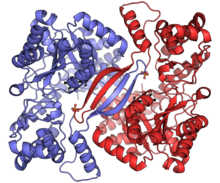| Alanine transaminase | |||||||||
|---|---|---|---|---|---|---|---|---|---|
 | |||||||||
| Identifiers | |||||||||
| EC no. | 2.6.1.2 | ||||||||
| CAS no. | 9000-86-6 | ||||||||
| Databases | |||||||||
| IntEnz | IntEnz view | ||||||||
| BRENDA | BRENDA entry | ||||||||
| ExPASy | NiceZyme view | ||||||||
| KEGG | KEGG entry | ||||||||
| MetaCyc | metabolic pathway | ||||||||
| PRIAM | profile | ||||||||
| PDB structures | RCSB PDB PDBe PDBsum | ||||||||
| Gene Ontology | AmiGO / QuickGO | ||||||||
| |||||||||
Alanine transaminase (ALT), also known as alanine aminotransferase (ALT or ALAT), formerly serum glutamate-pyruvate transaminase (GPT) or serum glutamic-pyruvic transaminase (SGPT), is a transaminase enzyme (EC 2.6.1.2) that was first characterized in the mid-1950s by Arthur Karmen and colleagues.[1] ALT is found in plasma and in various body tissues but is most common in the liver. It catalyzes the two parts of the alanine cycle. Serum ALT level, serum AST (aspartate transaminase) level, and their ratio (AST/ALT ratio) are routinely measured clinically as biomarkers for liver health.[2]
The half-life of ALT in the circulation approximates 47 hours.[3] Aminotransferase is cleared by sinusoidal cells in the liver.[3]
- ^ Karmen A, Wroblewski F, Ladue JS (January 1955). "Transaminase activity in human blood". The Journal of Clinical Investigation. 34 (1): 126–31. doi:10.1172/JCI103055. PMC 438594. PMID 13221663.
- ^ Djakpo, Dodji Kossi; Wang, Zhi Quan; Shrestha, Merina (26 December 2020). "The significance of transaminase ratio (AST/ALT) in acute myocardial infarction". Archives of Medical Science – Atherosclerotic Diseases. 5 (1): 279–283. doi:10.5114/amsad.2020.103028. ISSN 2451-0629. PMC 7885810.
- ^ a b Giannini EG, Testa R, Savarino V (February 2005). "Liver enzyme alteration: a guide for clinicians". Canadian Medical Association Journal. 172 (3): 367–79. doi:10.1503/cmaj.1040752. PMC 545762. PMID 15684121.
Aminotransferase clearance is carried out within the liver by sinusoidal cells. The half-life in the circulation is about 47 hours for ALT, about 17 hours for total AST and, on average, 87 hours for mitochondrial AST.